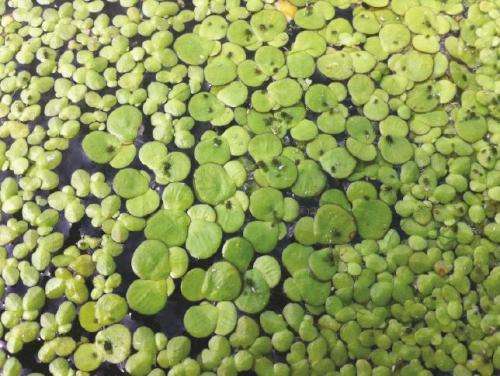A plant catalogued as extinct in Catalonia is rediscovered

Spirodela polyrrhiza is the name of a small floating plant not seen in the Mediterranean basin for more than 80 years. The plant, catalogued as extinct in Catalonia, has been found in the lower course of the Ebro River and the Vallvidrera reservoir (Catalonia, Spain). The finding in the Ebro River is described on an article published in the journal Flora Montiberica, by Núria Bonada, from the Department of Ecology of the UB, and Óscar Gavira and Tony Herrera Grao, from the company Mediodes Consultoría Ambiental y Paisajismo. This scientific finding is also described on an article published in the journal Orsis 27 written by experts of the Scientific Research Group Terres de l'Ebre.
A giant in the family of duckweeds
The species Spirodela polyrrhiza, which belongs to the family of duckweeds, has a miniature body reduced to a floating disc from which several roots hang, without stems or leaves. With a diameter of about 10 millimetres, S. polyrrhiza is considered a giant in the family of duckweeds (for instance, Wolffia arrhiza's diameter is not longer than 1.5 millimetres).
It has a world-wide distribution; it also lives in the Iberian Atlantic basin. In Catalonia, it was only thought to be in the area of L'Empordà (Girona), and it was never identified before in the Ebro basin or the vicinity of Barcelona. In Catalonia, it was last referenced in the 1980s in Rosselló, and in the 19th century it was documented in Empúries. When the plant disappeared in Catalonia, it also vanished in the Iberian Mediterranean basin, as it was not identified any other hydrological point of this network.
"The plant lives in swampy and shady areas, backwaters of rivers and marshes; it shares its habitat with other species of duckweeds and macrophytes," explains Professor Núria Bonada, member of the Research Group Freshwater Ecology and Management (FEM) of UB.
No record of its presence for 80 years
More than 80 years later, S. polyrrhiza has been re-discovered in the lower course of the Ebro River, in Tarragona, and the Vallvidrera reservoir, near Barcelona. These findings are described in a study published recently on the Butlletí of the Catalan Institute of Natural History (ICHN), coordinated by the expert Pere Aymerich.
"The species was never identified again at its original location or in studies carried out in the Ebro River, so we think that it is an uncommon species that inhabits some particular habitats," says Núria Bonada. "The absence of potential habitat and the possible changes of hydrological regime of rivers could explain why the species has such a reduced distribution that it was considered to be to extinct. Authors say that the species has gone unnoticed, at least in the lower course of the Ebro River, "because phytosociological relevés have been done periodically."
Protection needed after re-finding
This is an important scientific finding because it brings S. polyrrhiza back to the catalogue of Catalan species. Its study will contribute to better management of natural areas. However, it is important to bear in mind that even if the species disappears from the catalogue of extinct species, the plant continues to be under threat.
Therefore, it is necessary to take measures to guarantee its conservation and avoid its 'apparent' extinction in the Iberian Mediterranean basin. "It is a species that can live in habitats with high concentrations of nutrients and organic matter, but changing water regimes or water timing (agricultural use, climate change, etc.) may reduce the size of populations," says Núria Bonada. However, species presence in the Ebro River is probably due to a recent colonization, so authors conclude that the species could be in an expansion phase.
More information: Presencia De Spirodela Polyrrhiza (L.) Schleid. (Araceae: Lemnoideae) En Cataluña. Óscar Noel Gavira Romero, Núria Bonada, Tony Herrera-Grao. Flora Montiberica. 55: 97-100 (3-X-2013). ISSN: 1138-5952, edic. digital: 1998-799X
Provided by University of Barcelona



















